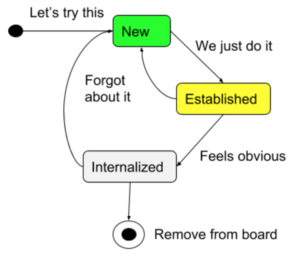You may have read about this elsewhere, but a recent event led me to write this. I feel that the working agreements concept is not given the attention it deserves. Working agreements are about making your culture explicit. It is desirable to have them visualised on your Scrum board as a constant reminder. Question is, when do we remove them from the board so that they don’t cover the whole board? My answer is, when the third state is reached, “internalised”.
A change in your working agreements is a typical outcome of your retrospective. Initially it is probably a change in your culture and the only thing you have agreed upon is to try it. Later you will evaluate how it turned out in practice. Perhaps it never picked up or it became an established part of your way of working.
When a working agreement has been established for a long time, it is so deeply rooted that you never need to be reminded about it. You do not need a post-it on your board saying “we wear clothes when at office”. It is internalized or if you wish, self-evident.
So a working agreement goes from being new, being established to being internalised. On the way it may be discontinued. A programmer at heart, I would like to illustrate the states in a diagram.
As you can see from the diagram, sometimes you take a step back. You simply forget about something you once agreed upon. It is important to stay cool about it, things like that happens. Bad habits can return because there was a logic to them in the first place, it could be a new member in the team or something else. It is an opportunity for reflection when you discover that you lost a good habit. Maybe the agreement is not that great or maybe the context has changed. If it is a valuable agreement it will stand, not to worry.
In practice
Decide on two colors, e.g. green and yellow, that represents the states of a working agreement. The last state need no color as you remove it from the board.
When you create a new agreement, write it on a green note together with the date when it was decided. The date is for later when you consider if an agreement has been established or not. Has it not been around for long, you probably can not call it established. Is it getting old and not becoming established, you need to consider why. Why have we forgot about it? Is it something wrong about it? Is it to vague, like “be nice”?
If you, as a team, agree that it is established, write it on a yellow note. I usually keep the original date but it might be interesting to also note the date it was established. That way you can see how long it takes to establish agreements.
As you learned from the diagram, it is possible to fall back and forget about an established agreement. When you do, write it again on a green note.
Finally, one day, you can say to yourself that an agreement feels self-evident. It has become an internal part of the team culture. It goes without saying. You can remove it from the board.
If that makes you feel a bit anxious, take it to an information graveyard, like your company wiki, and bury it there. The memory of it will be cherished every day as we carry it with us, forming the way we are against each other.
Gamification, how many do you know?
A small game I do to start a reflection upon our agreements, is to ask everyone to write down the agreements from memory. The one who knows most of them, wins. Simple, but sparks the discussion. Some were remembered by everyone and some by no one. Why? Because it is evident or because we do not respect it?
Lastly, I keep our agreements on a A3 paper so I can detach them from the board. It also a good size factor that limits the number of agreements.
See also this understand more on the benefits of working agreements: https://blog.crisp.se/2017/01/29/yassalsundman/role-expectations-and-working-agreements




